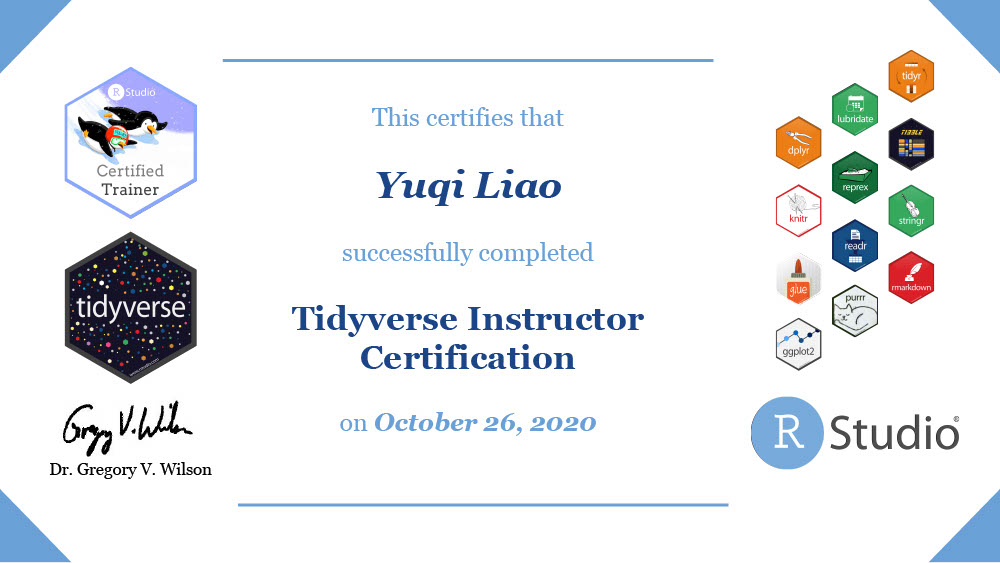Getting Certified as an RStudio Instructor
2020-12-03
I was lucky to have been certified as an RStudio instructor in Tidyverse in October this year (thanks for the financial support from my organization). I’d love to share my experience and what I’ve learned along the process, which I hope may be helpful to anyone interested in teaching R.

Signing up
RStudio has launched its Instructor Training and Certification Program in 2019 to help would-be trainers apply modern evidence-based teaching practices to teach data science using R, and to help learners find the trainers they need. Following the instruction on this page, I have signed up in April 2020. In June, I received an email that listed out the available instructor training sessions that I could enroll, among which I chose a session in August.
Instructor Training
The instructor training sessions were conducted online two days in a row, with each day covering about 4 hours of presentations, discussions, case studies, and exercises. In my cohort, there was a small group of 16 participants from all over the US/Canada, which made it easy for interactions and discussions. Greg Wilson, who leads this RStudio program, facilitated the training sessions. The training slides are all publicly available, but Greg’s presentation of the slides is where the value comes from, as well as the tips and experiences shared by fellow participants during the session. The training is a great way for me to get a glimpse of the latest theories and best practices in teaching. Here are some of the takeaways that I found especially helpful.
Create a learner persona before planning for the course. A learner persona is a brief description of a typical target learner for a lesson that includes their general background, what they already know, what they want to do, how the lesson will help them, and any special needs they might have. I like this approach because it emphasizes what the learner needs instead of what the trainers know or want to teach. I learned that it hardly works if a course was developed to cover more than 2 distinct personas.
Be aware of the expert blind spot. Experts (if they are not good teachers) may not be reminded that there are intermediates steps for a novice to get to a solution. Therefore, as trainers, it’s important to guide learners through a concept map starting with what they already know.
Be mindful of what demotivates students. I learned that there are many subtle ways in which a trainer may unintentionally demotivate a learner. For example, using words like “just” (e.g. “It’s easy, you just do this and that”) may signal to the learners that the problem is trivial. Besides, taking over learners’ keyboards to help them fix something instead of letting them fix it may be a demotivator too.
Mirror the learner’s environment. In teaching R, sometimes live coding is required where trainers need to show their screen. I used to share my screen where my RStudio has been customized to have a fancy black background and some keyboard shortcuts. Such customization is highly likely not mirroring the learner’s environment and may invite confusion. To resolve this, I learned that some teachers create a separate bare-bones teaching-only account on their laptops. Having a separate account on a laptop may also avoid any pop-up notifications from irrelevant applications.
Teach R remotely. Online teaching is becoming increasingly popular and necessary in 2020. The training has provided useful tips on learner engagement, class management, and technology. These two articles summarize well what’s being discussed during the training session.
Teaching Exam
The teaching exam is 90-minute that covers pedagogical techniques discussed in the instructor training. As part of the teaching exam, candidates are required to deliver a 15-minute demo lesson of any topic that needs to incorporate live coding and formative assessment. My demo lesson could be found here. RStudio also releases two sample teaching exams (version 1, version 2) for prospective trainers.
Technical Exam
Next, candidates need to pass technical exams to get certified. As of now, RStudio offers certification on the Tidyverse and Shiny, the exams are each 90-minute long. Candidates could choose to take either or both exams. I only took the Tidyverse exam and got its certification. Below are a few helpful exam prep resources.
Tidyverse
- Study material: R for Data Science (required); Advanced R (optional)
- Sample exams: version 1, version 2
Shiny
- Study material: Mastering Shiny (required)
- Sample exam: version 1
Overall impression
I’ve enjoyed the training and certification process and would encourage anyone interested to try it out. I found the Instructor Training to be especially helpful and will apply what I learn to future teaching opportunities. I am also grateful to learn about many high-quality open-source education materials (a great example is the RStudio Education page) that RStudio offers to the R community. Please feel free to reach out if you are interested in getting certified and would like to know more! 👾